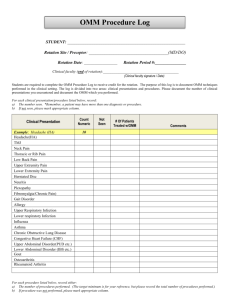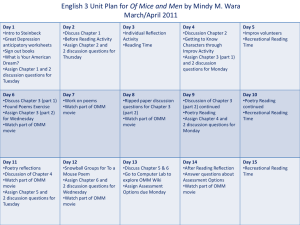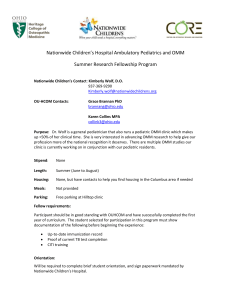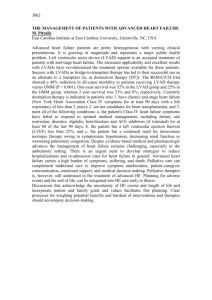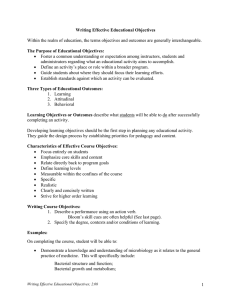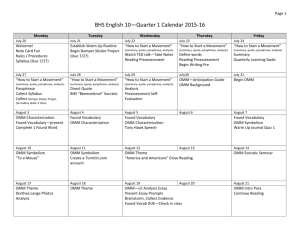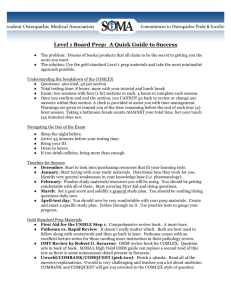Appendix D.14 Volume II Orbiter Major Modification Review COLUMBIA
advertisement
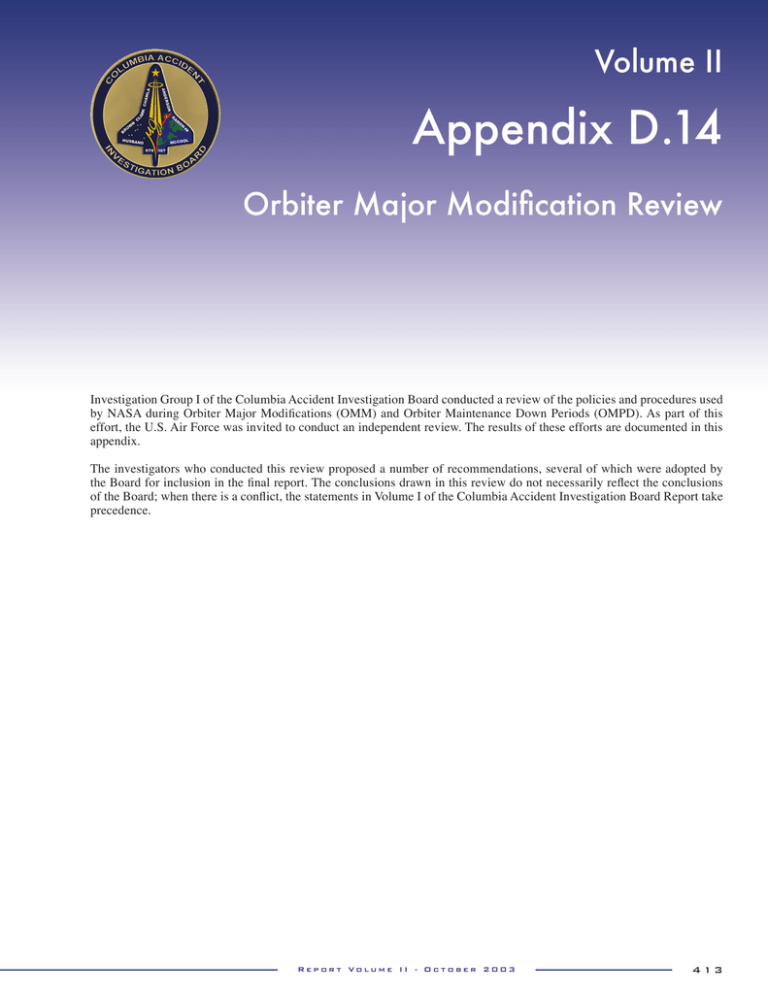
COLUMBIA ACCIDENT INVESTIGATION BOARD Volume II Appendix D.14 Orbiter Major Modification Review Investigation Group I of the Columbia Accident Investigation Board conducted a review of the policies and procedures used by NASA during Orbiter Major Modifications (OMM) and Orbiter Maintenance Down Periods (OMPD). As part of this effort, the U.S. Air Force was invited to conduct an independent review. The results of these efforts are documented in this appendix. The investigators who conducted this review proposed a number of recommendations, several of which were adopted by the Board for inclusion in the final report. The conclusions drawn in this review do not necessarily reflect the conclusions of the Board; when there is a conflict, the statements in Volume I of the Columbia Accident Investigation Board Report take precedence. Report Volume II • October 2003 413 COLUMBIA ACCIDENT INVESTIGATION BOARD THIS PAGE INTENTIONALLY LEFT BLANK 414 Report Volume II • October 2003 COLUMBIA ACCIDENT INVESTIGATION BOARD APPENDIX D.14 Orbiter Major Modification Review Submitted by Group I Major General John L. Barry, Brigadier General Duane W. Deal, Rear Admiral Stephen A. Turcotte Colonel Timothy D. Bair, John F. Lehman, Colonel David T. Nakayama 1.0 ISSUE shuttleʼs original manufacturer), and two at Kennedy Space Center (KSC). Figure 1 shows the OMM history. Review/assess past OMM performance, the movement of OMMs from Palmdale to Kennedy Space Center (KSC), and OV-102ʼs most recent OMM; identify significant issues and/or concerns. 2.0 The eight at Palmdale include OV-102ʼs “AA” OMM, which was a demodification from a test/development to an operational configuration. Both OMMs at KSC were OV-103, first for its J1 OMM (February to August 1992), and again for its J3 (in progress since Sep 02). The durations of each OMM has varied widely, ranging anywhere from 5.7 months (OV-102/J1) to 19.5 months (OV-104/J1); the OV-102/J3 OMM, at 17 months, was the second longest in program history. The time duration of an OMM is driven more by the number of modifications than by recurring inspections and maintenance, and the wide variation is the result of differences in OMM content. BACKGROUND The Space Shuttle Program Requirements, NSTS 07700, Volume III, establishes the requirement for each Orbiter to undergo an OMM every 8 flights or 3 years. Orbiters are removed from service for varying amounts of time to accomplish OMMs, depending on the amount and type of work to be performed. This work includes baseline requirements, such as component changes based on time and/or cycles; routine inspections, such as structural components; special inspections, such as the wiring work performed on OV-102 in the aftermath of the short circuit on STS-93; modifications, deferred work, and correcting “stumble ons” (estimated to be at least 40 percent of the total work performed). Besides OMMs, two other opportunities to perform Orbiter inspection and maintenance occur during the “standard flow” that is part of every mission. An OMM is a subset of an OMDP, although OMMs are not part of every OMDP. There are vastly more inspection and maintenance requirements during an OMDP; a recent comparison showed 8,702 OMDP/OMM requirements (STS-109) versus 3,826 for a standard flow (STS-111), or 127 percent more. OMMs typically involve the most intrusive inspections, maintenance, and modifications compared to a flow. 3.0 OMM INTERVALS – SHOULD THEY BE EXTENDED? Over the history of the Space shuttle Program, the challenge with scheduling Orbiters for OMM has been accomplishing interval/periodic requirements as close to the specified interval as possible without exceeding them, while simultaneously supporting the launch schedule (manifest) and having no more than one Orbiter undergoing OMDP at a time. Because of these scheduling complexities, some latitude in the 8-flight/ 3-year interval is allowed, as long as requirements are met through actions during flows. This can be seen in the number of Orbiters that have exceeded the 8 flight/3 year interval: OV-102 had 9 flights and 4 years between its J2 and J3 OMMs; OV-103 had 9 flights and 4.5 years between its J2 and J3; OV-105 currently has 8 flights and over 5 years and, by the time of its next OMM, would have had 11 flights and over 6 years if the schedule prior to the Columbia accident was still in effect; finally, OV-104 would have 12 flights and 6 years by its October 2005 OMM if the pre-Columbia manifest was still in effect. Studies/analyses have been conducted since 1999 on how intervals might be extended to as much as 12 flights and 6 years, but there has been no decision to date. A general rule FINDINGS OMM HISTORY – WIDE VARIATIONS IN DURATION Ten OMMs have been performed in the history of the Space Shuttle Program (SSP): eight at Air Force Plant 42 in Palmdale, California, by Boeing (formerly Rockwell, the Report Volume II • October 2003 415 COLUMBIA ACCIDENT INVESTIGATION BOARD 1985 1986-1990 OV -102 AA 1/25/84 - 7/11/85 (18 mo) FIt 7 1991 1992 1993 1994 1995 1996 1997 1998 1999 2000 2001 2002 2003 OV -102 J1 8/15/91 - 2/7/92 (5.7 mo) FIt 12 OV -103 J1 2/17/92 - 8/17/92 (7 mo) FIt 15 OV -104 J1 10/19/92 - 5/27/94 (19.5 mo) OV -102 J2 FIt 13 10/13/94 - 4/10/95 (6 mo) FIt 18 OV -103 J2 9/29/95 - 6/24/96 (9 mo) FIt 22 OV -105 J1 7/30/96 8 mo) FIt 12 - 3/24/97 OV -105 J1 7/30/97 - 9/21/98 (10.2 mo) FIt 21 KSC OMM Implementation OV -102 J3 9/26/99 - 2/23/01 (17 mo) FIt 27 OV -103 J3 9/1/02 - 4/1/04 (19 mo) FIt 31 Figure 1. Orbiter Major Modification (OMM) history. in industry, however, is that time-based inspections become more frequent as vehicles age. This seems to run counter to the Space Shuttle Programʼs initiative of increasing the OMM interval. completed the last Orbiter (Endeavour, OV-105) there has been discussions of moving major maintenace from Palmdale to another site. During the late 1980s these discussions took the form of moving OMDPs to the Orbiter Maintenance and Checkout Facility at Vandenberg Air Force Base in California since it was a state-of-the-art facility. This concept was discarded on cost grounds, and the equipment from the VLS OMCF was later moved to KSC to equip OPF-3. Discussion then turned to moving major maintenance to KSC. While Palmdale had the advantage of being the manufacturing site, there were a large number of disadvantages, such as the high labor rate, the higher cost of basics such as utilities, and a “migrant” workforce that ebbed and flowed with each OMM. A 1995 NASA Inspector General (IG) report acknowledged a move to KSC would result in cost savings, but due to the complexity of scheduled work (including an aggressive launch schedule - eight were launched in 1996 and another eight in 1997), recommended leaving the next two OMMs at Palmdale. A second look by the NASA IG in 1998 reconfirmed that OMMs at Palmdale were costlier, but also stated risk was greatly reduced by performing them there, and that the risk of moving them to KSC outweighed potential cost savings. The report recommended reevaluating the feasibility of moving when significant changes occur (there were only four launches annually in 1998, 1999, and 2000, but no OMM movement). In the summer and fall of 2001, the JSC Systems Management Office (SMO) and the Space Shuttle Program conducted more reviews. The JSC SMO concluded that significant savings could be realized even comparing the worst case at KSC with the best case at Palmdale. Meanwhile, the launch rate rose to seven in 2001 and six in 2002, levels of activity nearing those when the NASA IG had recommended not moving OMMs from Palmdale. Nevertheless, in February 2002, the NASA Administrator approved performing OV-103ʼs OMM at KSC, beginning in September 2002. The staffing package specifically cited FY 03 budget shortfalls and their impact on FY02 OMM CONTENT – WHERE ARE MODIFICATIONS REALLY PERFORMED? More modifications are performed during flows than during OMM. Thirty-six percent, or 2,177 of the 5,985 total modifications across the fleet were done in OMMs, whereas 3,808, or 64 percent, were accomplished during flows. While these numbers alone do not indicate the relative simplicity or complexity of each mod, they do reflect a philosophy of scheduling simpler, less intrusive mods during flow rather than deferring them to OMM. This leaves OMMs with increased flexibility for more complex mods and unexpected problems. Figure 2 shows the numbers of mods performed in OMMs/flows. ORBITER MODS IN OMM MODS IN FLOW TOTAL MODS OV-102 608 1,058 1,666 OV-103 675 936 1,611 OV-104 691 725 1,416 OV-105 203 1,089 1,292 2,177 3,808 5,985 TOTAL Figure 2. Modifications performed in OMM vs. flow. OMM LOCATION – PALMDALE OR KSC? A major change in location occurred with the move of OMMs from Palmdale, the Orbitersʼ birthplace, to KSC, starting with OV-103 in September 2002. Since Palmdale 416 Report Volume II • October 2003 COLUMBIA ACCIDENT INVESTIGATION BOARD as short-term factors, and overall life cycle cost reduction as a long-term factor weighing on the decision. Though a reduced launch rate is reported to have been a consideration, the decision packages only mention budgetary concerns and, given the increasing number of launches in 2001 and 2002, the reduced launch rate appears to have been a secondary consideration, at best. just to mention a few) have generally atrophied due to the lack of activity. There are a few exceptions where Boeing is currently the sole source provider of services to the Space Shuttle Program (manufacture of 17 inch disconnects and cold plates). The Palmdale machine shop is another capability that has not atrophied, not because it is a sole source supplier, but primarily due to its support of other non-Space Shuttle Program requirements; what is important is that it is used by NSLD for reserve/overflow capacity. Palmdale/KSC Infrastructure Comparison Workforce Efficiency, Flexibility, and Capacity A comparison of the infrastructure at both locations shows them to roughly be on par. KSC has three processing bays, whereas Palmdale has two. KSC became “maxed out” after the move, with four Orbiters and only three bays. One illustration of the impact of this Orbiter overpopulation is OV103ʼs movement at least 6 times in 9-months while awaiting an OMM location decision. These moves unnecessarily consume manpower, take time, can be disruptive if maintenance is in progress, and creates opportunities for mistakes; when OMMs were performed at Palmdale, this was typically not an issue. The loss of Columbia alleviated this situation since there are only three remaining Orbiters. Work force/labor expenditures appear more efficient at KSC, but differences in tracking methodology and the newness of OMMs at KSC make it too early for any definitive conclusions. The last four Palmdale OMMs ranged anywhere from 324 to 448 equivalent personnel (EP), with an average of 383. OV-102 required 394 EP and took 17 months, whereas its predecessor, OV-104 required 448 EP but only took 10.2 months. KSC augmentation of the Palmdale work force with 30 to 40 technicians, inspectors, and engineers also occurred on a regular basis; some of this was due to KSCʼs familiarity/ proficiency with “power-on” requirements. During the first 9 months (Sepember 2002 – May 2003) of OV-103ʼs OMM at KSC, an average of 307 EP have been required, compared with a projection of 235. While the number of EP is higher than forecasted, this is probably due to increasing requirements (discussed later in this chapter) and is still lower than the EP required for OV-102 at Palmdale. There are several potential reasons favoring more efficient work force utilization at KSC, and these factored heavily in the decision to move OMMs to KSC. When all Orbiter work (OMDPs and standard flows) is considered, there is a larger amount at KSC. This requires a larger overall workforce, which, in turn, allows management the flexibility to reallocate manpower to match specific peaks and valleys associated with each Orbiter. While workers may not always be working on an OMM, they are more likely to be consistently doing Orbiter work at KSC. This contrasts with the “nomadic” work force at Palmdale, which, after an OMM was complete, moved to other jobs (not necessarily on Orbiters or in aviation) until the next OMM. The steadier overall Orbiter workload at KSC thus serves to keep worker proficiency at a higher level and, more importantly, preserves Orbiterrelated proficiency (a much higher standard compared to general aviation). It is important to note that the larger, more versatile work force and improved efficiency at KSC are not limited to technicians; it also applies to management and staff (planners, schedulers, engineers, etc). However, one concern voiced by senior managers is the ability of the work force to focus because of their increased “fluidity” (i.e., moving between OMM and down-/up-mission processing); this may apply even more to management and staff personnel (given that technician workload is very structured), and needs to be carefully monitored. Figure 3. OV-102 undergoing OMM at Boeingʼs Palmdale facility. Support equipment capabilities are comparable, with a slight advantage at Palmdale when it comes to large component removal and installation. This is the result of Palmdale being the original manufacturing site and having, among other assets, large overhead hoists. Other pieces of support equipment were shared/shipped between KSC and Palmdale. Figure 3. shows OV-102 in OMM at Palmdale. Palmdale/KSC Logistics Comparison In terms of logistics, the steady improvement of the NASA Shuttle Logistics Depot (NSLD) in Florida over the years has reduced the need for expensive, duplicate capabilities on the West Coast. Even prior to the OMM move, support to Orbiters in OMM at Palmdale was increasingly coming from NSLD. For the last OMM at Palmdale (OV-102), 2,663 orders comprising 76,894 pieces were shipped from NSLD; these included hardware, line replacement units (LRU), and consumables. For the OMM prior to OV-102 (OV-104), 1,538 orders comprised of 47,487 pieces were shipped from the NSLD. The majority of Palmdaleʼs industrial shops (Thermal Protection Systems, Avionics, and Wiring, Report Volume II Workforce Experience and Training Workforce inexperience can also be handled with less impact in a large workforce, as at KSC. For the OMM relocation to KSC, 176 additional workers were hired. These new hires were dispersed throughout the entire workforce • October 2003 417 COLUMBIA ACCIDENT INVESTIGATION BOARD of 1,900 to minimize their training load/impact; the larger workforce, compared to Palmdale, was better able to absorb inexperienced technicians. By comparison, the OV-102 OMM at Palmdale shows how a smaller workforce is less able to deal with this kind of challenge. Palmdaleʼs initial workforce of 342 had an 85 percent experience level (either previous OMM work or Orbiter manufacturing). Key personnel had been strategically placed in other Boeing organizations to keep them employed when there was no OMM work and have them available for recall as OMMs were scheduled. However, as OV-102ʼs OMM workload increased (with new, post roll-in requirements), the workforce had to be expanded to 500; in this expansion, experienced personnel were “tapped out” and the experience level dropped to 58 percent; simultaneously, the time spent training new/inexperienced workers increased, including on-the-job training. INITIAL PLANNING CCB BASELINE PERCENT INCREASE OV-103 J2 9/95 – 6/96 383 532 39% OV-105 J1 7/96 – 3/97 278 405 46% OV-104 J2 11/97 – 9/98 461 844 83% OV-102 J3 9/99 – 2/01 330 671 103% OV-102 J3 w/o Wire Insp 330 591 79% ORBITER Figure 5. Comparison of OMM Requirements Growth. PALMDALEʼS LAST OMM – OV-102 More important than the increasing numbers of requirements or the percent growth is the manner in which the changing requirements were managed. An independent assessment of the OV-102 OMM by HEDS, the Human Exploration and Development of Space office, summarized the OV-102 OMM in terms of cost and schedule slippage as “poor performance on the parts of NASA, USA, and Boeing.” The same report noted, however, that “Work quality was very good to excellent.” The last OMM at Palmdale, OV-102, requires comment because problems encountered should serve as valuable “lessons learned” for future work, regardless of location. It was the first OMM completely managed by United States Alliance with Boeing subcontracted to do the work. OV102 rolled into OMM at Palmdale on 26 September 1999 and rolled out on 24 February 2001. The contractor initially forecast OMM duration at 331 days, but the Space Shuttle Program Office directed it downward to 293 days based on “considerations of repeat modifications and a lesser workload.” Its actual duration was 517 days, a 76 percent growth. Despite this, it rolled out with 98 percent of all work complete. Major modifications included, but were not limited to MEDS (Multifunction Electronic Display System, aka glass cockpit), GPS (Global Positioning System), and wireless video. There was a large growth in requirements (see Figure 4.) – 103-percent since the preplanning baseline 10 months prior to roll-in. More specific examples of these general comments follow. Palmdale had an adequate workforce, both in numbers and skill, to perform OV-102ʼs OMM as originally planned, but unforeseen problems and added requirements quickly exceeded Palmdaleʼs capabilities. The number of requirements established at the Modification Site Requirements Review grew by 103 percent, although this was the planning baseline for resource allocation; additionally, it grew by 82 percent after roll-in. An extremely invasive wiring inspection, based on identifying and correcting the root cause of an anomaly during STS-93, was added 1-month after roll-in; 8 additional weeks were estimated for this add-on, based on the expectation of 500 to 700 anomalies; in reality, over 4,600 were found; as anomalies were identified and analyzed, the CHIT directing the inspection was revised six times, adding further turmoil. Other technical surprises such as the accidental discovery of cold plate corrosion, and When OV-102ʼs requirements growth is compared with the three previous OMMs, Columbia exceeds all three, with the next highest being approximately 20 percent less; with wiring inspection requirements removed from the comparison, OV-102 still has the second largest rate of increase, but only by 4 percent. Preplanning Baseline (11/06/98) Initial Baseline (04/01/99) Baseline Wire Insp (10/13/99) CCB Baseline (10/25/00) CCB Baseline (01/31/01) Percent Growth (since 1998) MCRs 66 70 75 99 102 85% Mod Kits 62 68 80 142 152 145% Tech Orders 28 36 42 56 58 107% TCTIs & NSW 55 58 68 100 110 100% Deferred WADs 105 150 194 204 206 96% Chits 14 17 20 37 43 207% Total 330 399 479 638 671 103% Figure 4. Ov-102 OMM Requirements Growth. 418 Report Volume II • October 2003 COLUMBIA ACCIDENT INVESTIGATION BOARD AIR FORCE PROGRAMMED DEPOT MAINTENANCE (PALMDALE) BENCHMARKING VISIT procedural problems such as payload door rigging taking twice as long as expected, stretched the schedule out and, combined with the wiring inspections, slipped the all-critical power-on testing phase. The contractorʼs OMM flow manager was inexperienced and messages to the Space Shuttle Program regarding key milestones were regularly optimistic. The contractor used a new, unproven scheduling tool that was eventually assessed as inadequate; management returned to the previously used tool 12-months into the OMM. The rapidly increasing number of non-conformances made integration of the workload increasingly difficult. Integrated scheduling meetings were held weekly (vice daily) and were not frequent enough to stay abreast of the rapidly changing scope of work; it was not until 12 months into the OMM that daily meetings were held. The Space Shuttle Program Office exacerbated the situation by turning the OMM management process over to the contractor without a structured insight function in place. In June 2003, an Air Force Depot Maintenance Team conducted an OMDP/OMM benchmarking visit for 4-days at the invitation of NASA Code M. The team was led by an Air Force program manager and comprised of five civil servants with extensive experience in the Air Forceʼs Programmed Depot Maintenance system; specific areas of expertise included requirements/sustainment engineering, planning, scheduling, quality assurance, safety, training, and industrial production. Areas worthy of benchmarking from an Air Forceperspective included the painstakingly meticulous documentation (WADs, or Work Authorization Documents), adherence to policy and procedures (traceability of inspection/maintenance requirements from source documents), logistics support (NASA Shuttle Logistics Depot), “ship side” engineering support (engineers in the Orbiter Processing Facility), safety (“time out” policy), and communication (numerous meetings to stay abreast of OMM progress). Areas requiring review/ increased attention on NASAʼs part included instituting a better closed loop feedback process for requirements definition (e.g., the Master Verification Plan, the Operations and Maintenance Requirements Specification Document, and the Quality Planning Requirements Document) to keep them updated as changes occur, increased planning and scheduling stability, incorporating Orbiter sustainment roadmap requirements into OMMs, and reviewing government/contractor relationships to ensure the right contractor “behavior” is being encouraged/incentivized. The issue of closed loop feedback is extensively addressed in this report under Safety and Mission Assurance (S&MA), but is equally applicable to inspection and maintenance requirements (MVP and OMRSD). Increased planning and scheduling stability were previously addressed as a “lesson learned” from the OV-102/J3 OMM, and also from the current OV-103/J3 OMM. Sustainment roadmap issues are addressed separately in this report under Service Life Extension Program (SLEP) and Mid-Life Certification (MLC), just as government/contractor relationships are. In summary, the Air Force OMM Benchmarking Visit duplicated/validated issues already being examined by the Columbia Accident Investigation Board and was an excellent second look. It is important to reiterate that, despite these problems, a commitment to excellence prevailed and OV-102 was rolled out with 98 percent of all scheduled work complete. “Traveled work”, the work carried forward to KSC and completed there, amounted to 9,071 hours, or 0.66 percent of the total work. By comparison, traveled work following OV-102ʼs J2 OMM was 0.89 percent (7,886 hours), and OV-103ʼs J2 was 0.38 percent (2,252 hours). All traveled work was fully coordinated and there were no surprises at KSC. OV-103ʼS OMM – WERE LESSONS LEARNED FROM OV-102? It appears lessons learned from the OV-102 J3 experience are being applied to the OV-103 J3 OMM, currently in progress at KSC. For example, efforts at better communication include scheduling meetings three times a week, reviews by Ground Operations managers twice weekly, and monthly Project Management Reviews (PMR) chaired by the JSC Orbiter Project Manager, all with close attention to critical path. There also appears to be a healthy “give and take” at the PMRs, and capabilities assessments for resource-constrained areas are presented at PMRs. However, the OV-103 OMM still demonstrates room for improvement. For example, the problem of requirements growth continues, to a greater extent than OV-102; there were originally 20 scheduled modifications for OV-103, reportedly due to budget constraints and also due to a conservative approach since this was the first OMM at KSC in 10 years; hence, many planned mods were “shelved”; however, 9-months (75 percent) through the OMM, the number of mods being performed has increased to 84 (320 percent growth, far worse than OV-102ʼs 103 percent growth) as mods are being “pulled off the shelf” and added; while the OMM critical path is closely monitored and workload is being relatively well-managed (e.g., another 24 mods are being held), the added work again introduces turmoil and increased potential for mistakes. Despite this requirements growth, OMM flow managers seem to be coping fairly well. However, the requirements growth adds an unnecessary unplanned/ unscheduled dimension to the OMM requirements. An independent Air Force Programmed Depot Maintenance benchmarking team made the same observation with the same concerns. Report Volume II 4.0 CONCLUSIONS While there are specific baseline elements to every OMM, no two are alike; variations in content will occur, and should be expected to continue to occur, based on aging requirements (wiring inspections, cold plate corrosion), on mission requirements (reconfiguration for Mir), and in some cases due to fluctuating resources (budget). However, improving planning/scheduling stability, to include factors for the “unknown-unknowns”, and instituting increased consistency is needed to reduce the wide variations in OMM duration and make the flow more manageable. Increasing OMM intervals as the Orbiters age is counter to industry norms and, for high performance systems, raises even greater questions. While no decision has yet been made, NASA must carefully study the implications of such a decision. • October 2003 419 COLUMBIA ACCIDENT INVESTIGATION BOARD Relocating OMMs from Palmdale to KSC, while heavily driven by cost and budget, was a sound decision from an overall program perspective. However, it creates new challenges that must be readily recognized and quickly addressed. For example, even KSCʼs increased capabilities can be overwhelmed if not carefully managed. Additionally, several NASA, USA, and Boeing senior managers have expressed concern over the ability of a fluid workforce (i.e., one that is being shifted between different Orbiters to respond to workload peaks and valleys) to focus on the task at hand. 4. NASA “Orbiter Maintenance Down Period (OMDP) Overview – Implementation” briefing, 9 Jun 03 5. Shuttle Ground Operations OMM Quality briefing, 9 Jun 03 6. Boeing/Palmdale OMM briefings/tours, 14 May 03 7. USA briefing, “OV-103 J3 OMDP Project Management Review”, 1 May 03 8. USA briefing, “Delta MSFR OV-103 J3 OMM”, 17 Apr 03 9. USA briefing, “KSC and Palmdale OMDP Comparison”, 26 Feb 03 10. USA briefing, “Orbiter Modifications”, 8 Feb 03 11. GAO response to Senator Boxer, “Relocation of Space Shuttle Major Modification Work”, 2 Dec 02 12. JSC/AC5 memo to JSC/MA (SSP) et al, “Trip Report: Orbiter Processing Facility, Bay 3, Orbiter OV-103 Maintenance Down Period (OMDP) Inspections and Upgrades, 8 Oct 02 13. USA briefing to PRB & PRCB, “OV-103 OMDP-3 Mod Site Flow Review (MSFR)”, 13/15 Aug 02 14. JSC Systems Management Office briefing, “Response to the GAO Audit of the Decision to Move the Orbiter OV-103 OMM to KSC”, 18 Jul 02 15. Code M briefing to Senator Feinsteinʼs staff, “Orbiter Major Modifications (OMM), 26 Jun 02 16. JSC/AC5 memo to JSC/MA (SSP) et al, “OV-103, Discovery, Maintenance Upgrades”, 18 Apr 02 17. NASA Code M memo to NASA Administrator, “Should OMMs be moved from Palmdale to Florida?”, 16 Jan 02 18. USA briefing, “OV-103 J3 Pre-Decision Package Summary”, 19 Dec 01 19. Space Shuttle Program (MA-01) memo to NASA Code M, “Orbiter Vehicle –103 (OV-103) Orbiter Major Down Period (OMDP), 21 Nov 01 20. HEDS/IA briefing, “OV-103 J3 OMM Assessment”, 14 Nov 01 21. HEDS/IA Report KS-0003, “Evaluation of the Current (OV-102) Orbiter major Modification (OMM) Flow, Mar 01 22. NASA/IG Report, “Followup Audit on Orbiter Maintenance Down Periods at KSC”, 12 Jun 98 23. NASA/IG memo to Code M, “Final Rapid Action Report [on] Impacts of Performing Orbiter Maintenance Down Periods (OMDPs) at KSC versus Palmdale”, 24 Oct 95. The wiring inspection CHIT and its timing, 1-month after OV-102ʼs roll-in, played a major role in OV-102ʼs schedule slippage and cost growth. It is representative of “technical surprises” that will likely continue, particularly as the Orbiters age, with no option other than “must do”. The overall OV-102/J3 OMM experience presents a multitude of lessons learned that have fleet implications because, as the Orbiters age, workload will likely increase; so will technical surprises, as mentioned above; and a significant return-to-flight workload is also probable. All of these factors will combine to generate new challenges for both managers and the workforce. 5.0 PROPOSED RECOMMENDATIONS The Space Shuttle Program Office must work to achieve greater stability, consistency, and predictability in OMM planning, scheduling, and work standards, particularly the number of modifications. Continually changing schedules, predominantly because of requirements growth, create unnecessary turmoil and can be detrimental to product quality. Templates for “standard work” must be developed and refined through use in planning and scheduling. Both NASA and United Space Alliance managers must understand workforce and facilities capabilities, match them against requirements, and take action to avoid exceeding thresholds. NASA and USA Space Shuttle Program managers should continue to benchmark with the Air Force in the areas of program management, coping with aging systems, life extension programs, mid-life certification, workload planning and scheduling, work force management and training, quality assurance, etc; the initial Air Force visit in Jun 03 was only the beginning of a potentially great exchange of ideas and practices. As much as possible, both Air Forceand NASA personnel involved in these benchmarking events should remain the same to overcome initial learning curves. The SSP Office must determine how it will effectively meet the challenges of inspecting and maintaining an aging Orbiter fleet Prior to lengthening the OMM interval. REFERENCES 1. Air Force Assistance Visit briefing, “NASA Orbiter Maintenance Down Period/Orbiter Major Modification, 17 Jun 03 2. USA briefing, “OV-103 J3 OMDP Project Management Review”, 12 Jun 03 3. NASA “OMDP/OMM Requirements Overview” briefing, 9 Jun 03 420 Report Volume II • October 2003
